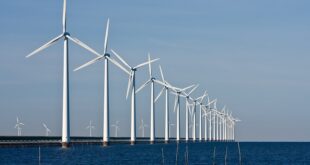The UK led the installations of offshore wind turbines in Europe in the first half of 2019.
According to latest statistics from WindEurope. the UK installed 931MW of offshore wind capacity. followed by Denmark (374MW). Belgium (370MW) and Germany (252MW).
The offshore wind installations in Britain included the Hornsea 1 project. which when completed. will be the largest project of its kind in the world. with a capacity of 1.2GW.
The total new wind energy capacity in Europe topped 4.9GW in Europe in the first half of this year. an increase from 4.5GW during the same period last year. however. onshore installations were down due to serious issues in Germany.
In total. Europe installed 2.9GW of onshore wind capacity. down on the 3.3GW of capacity installed in the first six months of 2018.
Germany had its worst first half of the year since 2000. however while installations are expected to pick up in the second half of 2019. grid-connected volumes in the country as a whole will be lower than historic levels. the report adds.
Wind energy currently makes up around 14% of the electricity generation in Europe – up from 12% in 2017.
Europe invested around €8.8 billion (£8.1bn) in the construction of future wind farms in the first six months of 2019. with €6.4 billion (£5.9bn) in onshore wind and €2.4 billion (£2.2bn) in offshore wind.
These investments. led by France and the Netherlands. will result in the addition of 5.9GW of capacity to the grid over the next two to three years.
WindEurope warns the rate of installations seen so far this year won’t be enough to help the EU reach its renewable energy goal of 32% for 2030
Pierre Tardieu. Chief Policy Officer at WindEurope said: It was a good start to the year for offshore wind growth. But offshore wind installations were poor these past six months. Germany has the lowest first half of the year for new onshore wind installations since 2000. Permitting challenges remain the key bottleneck: 11GW of onshore wind are stuck in the permitting process in Germany. And the transition to auctions. where so-called ‘community projects’ were allowed to bid in auctions without a permit back in 2017. has been messy. Many of these projects still need to be built.
European countries are finalising their National Energy &. Climate Plans to 2030. They should be giving as much detail as possible on the policy measures that will allow a smooth and robust deployment of renewables. The auction schedule. what they will do to streamline permitting. how they will replace the wind farms that are coming to the end of their operational life. It’s this kind of detail the industry needs to plan ahead and help deliver on Europe’s climate and energy ambitions cost effectively.
 Iran Energy News Oil, Gas, Petrochemical and Energy Field Specialized Channel
Iran Energy News Oil, Gas, Petrochemical and Energy Field Specialized Channel




